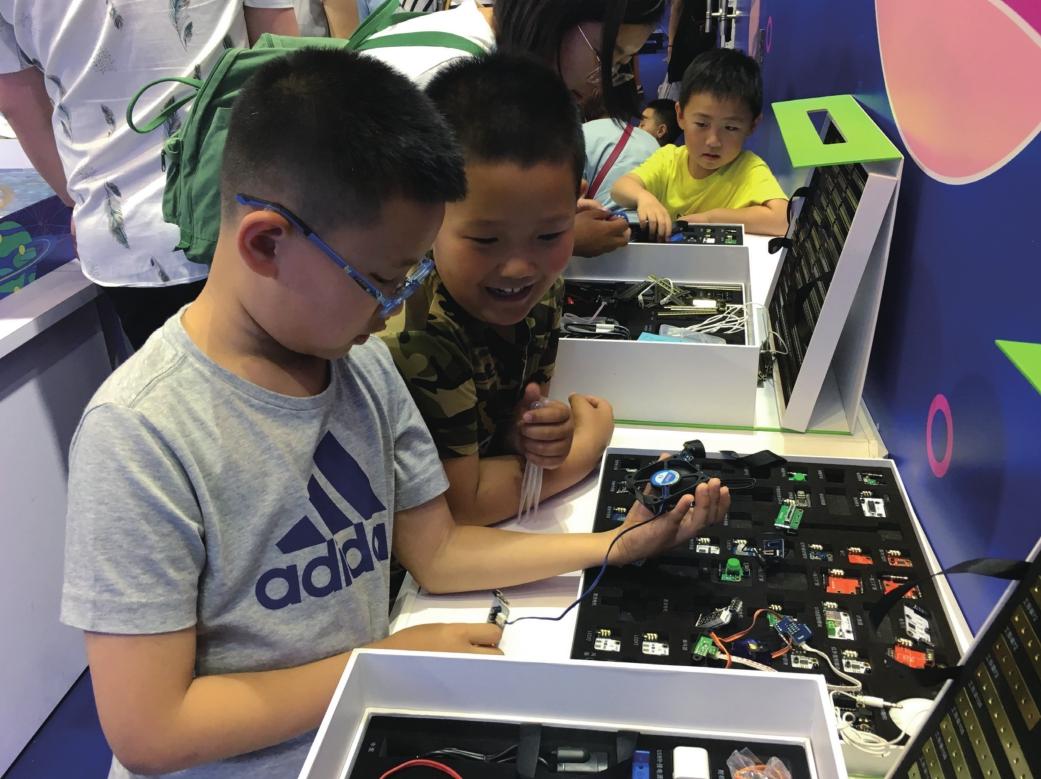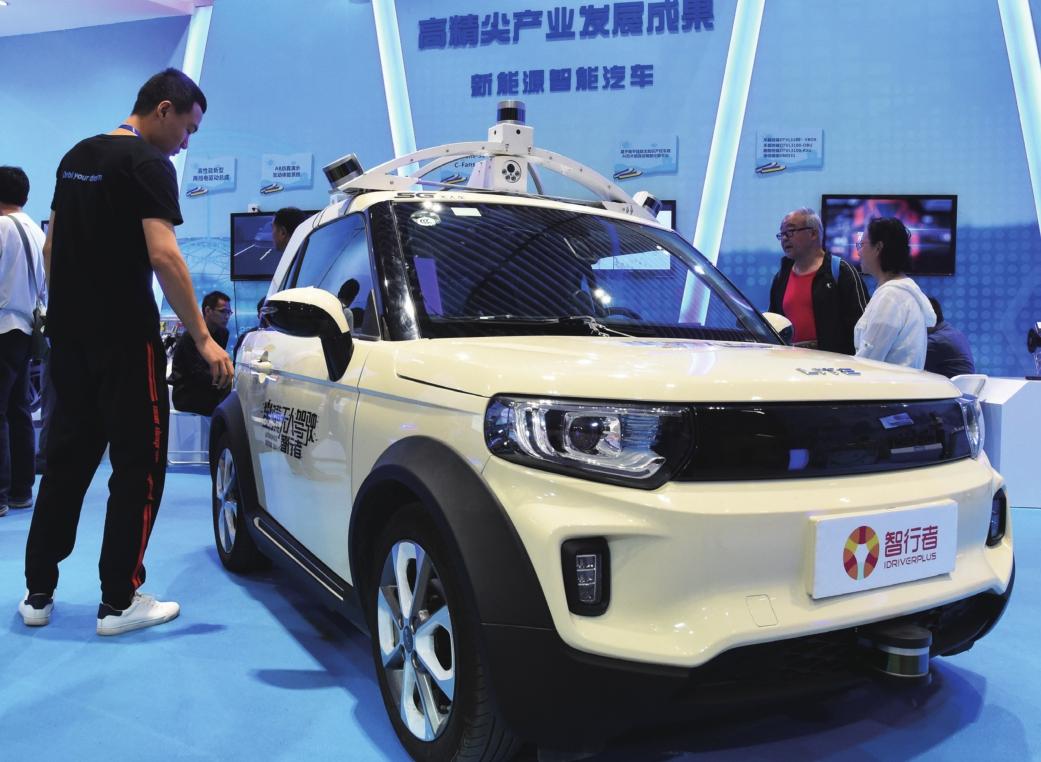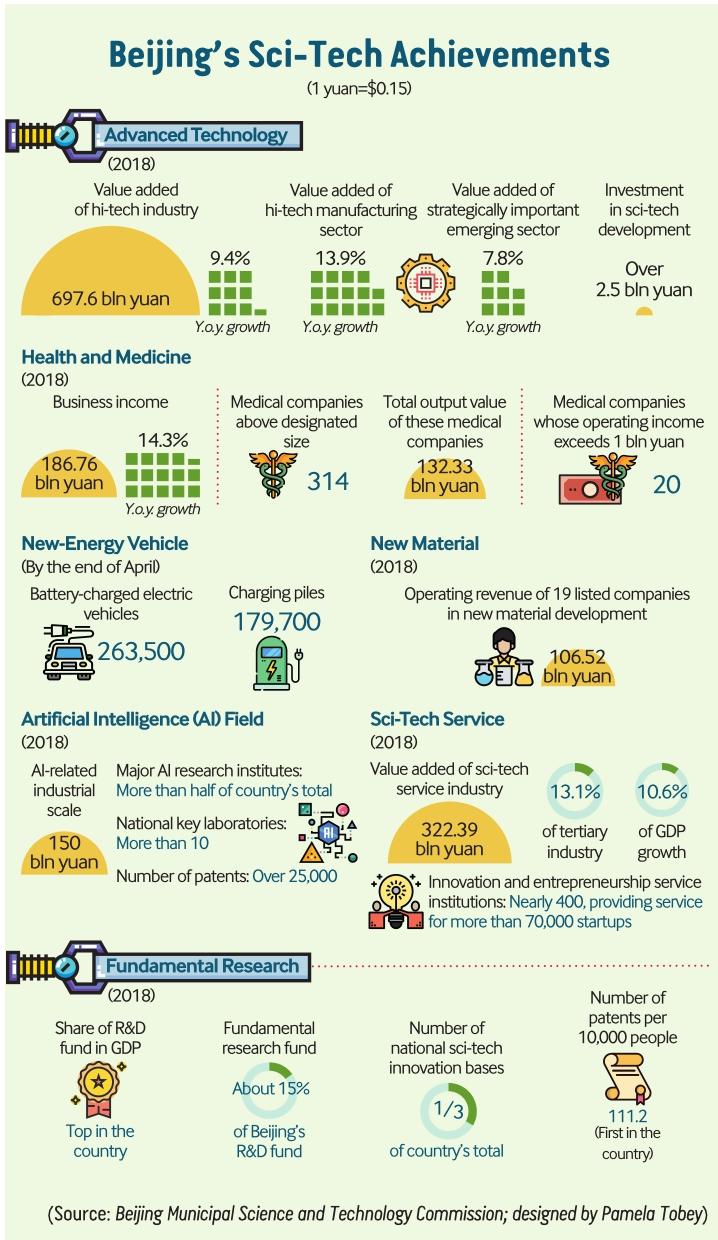Hi-Tech for All
2019-06-11ByLuYan
By Lu Yan

In 2008, William Cai co-founded Jing-Jin Electric, a company specializing in motor systems and electric drive assembly for newenergy vehicles (NEVs). Its hard to imagine that in just over a decade, the company that started with only 12 employees has become a leader in the field, exporting its core components to global partners like Waymo and Chrysler.
“We hope to help elevate the global com- petitiveness of Chinas core technology so as to go even further,” Cai said at a press conference on Beijings science and technological innovation development on May 22.
Making progress
Since 2014, Beijing has been making great efforts to become a technological innova- tion center in China. At the end of 2017, the Beijing Municipal Government released a series of policy documents on accelerating the capitals sci-tech development and building advanced economic structures, clarifying the specifi c development plans for 10 major high-grade industries, including new generation of information technology, integrated circuits, health and medicine, smart devices,energy conservation and environmental protection, NEVs, new materials, artificial intelligence (AI), software and information services, and the sci-tech service industry.
The industrial development of advanced and sophisticated sci-tech is leading Beijings economic growth. Liu Hui, Associate Inspector with the Beijing Municipal Science and Technology Commission (BSTC), said at the press conference that in 2018, the GDP of the capital reached 3 trillion yuan($434 billion), and the value added of the new economy exceeded 1 trillion yuan ($148 billion), including 697.6 billion yuan ($100.8 billion) of the value added of the hi-tech industry.
To ensure strong momentum, the city has strengthened investment and facilitated the establishment of innovation funds at a scale of 18.6 billion yuan ($2.69 billion).
Beijing Infervision Technology, a young technology company, is riding this tide. Founded in 2016, it is committed to analyzing DR, CT and MRI images through deep learning. The cancer screening system it has developed reduces the substantial workload and generates faster and more accurate diagnoses for radiologists.
“The combination of AI and doctors can help elevate the medical level of hospitals and help them provide more quality services for the public,” said Zhang Qingyue, the companys product manager.
Headquartered in Beijing, the company also established branches in cities in Japan, the U.S. and Germany, aiming to become a leader in the medical imaging AI field. According to its official website, as of February, the company had partnered with more than 300 top hospitals and medical institutions worldwide, helping physicians with over 33,000 diagnoses every day.
In terms of Beijings fundamental research, a series of policies were introduced in 2018 to support the development of new research and development (R&D) institutions and scientifi c research personnel. Three science parks were built as bases for cuttingedge R&D.
The municipal government also supports young scientists and their teams in making new breakthroughs. According to official statistics, 30 programs were funded last year, with the average age of research members 37.7. Through these programs, groundbreaking achievements have been made such as the worlds first smartphone using an AI processor. “Their research focuses on several original problems starting from zero,”said Zhang Guanglian, Deputy Director of the BSTC.
A trans-regional cooperation platform is also under construction, which will cover Beijing and neighboring Tianjin and Hebei Province to push forward the communication and collaboration of scientific and research teams in the three areas based on the Central Governments Beijing-TianjinHebei integrated development plan.
Furthermore, the service sector has expanded to facilitate the development of the sci-tech innovation sector, with a focus on engineering technical services, sci-tech finance, R&D services and design services. Relevant industries such as business incubation, intellectual property and technology transfer are also enjoying fast growth.
The capital has also worked on the commercialization of sci-tech research fi ndings. For instance, an action plan was released in 2016 to complete major tasks like setting up a platform for the collection and distribution of scientific results; facilitating the collaboration between companies and academic institutions, scientifi c research institutes and medical organizations; establishing incentive mechanisms; and strengthening marketoriented services, among others. It has ensured progress in turning research results into products for use in peoples daily life.
Practical and fun
On May 19-26, a sci-tech exhibition week was held in Beijing where colleges and universities, scientifi c research institutes, and hitech companies displayed nearly 300 of their latest sci-tech innovations in AI, integrated circuits, aerospace, smart devices, cuttingedge materials and others.
One of the exhibitors was Beijing PINS Medical, which was established in 2008 and is an innovative hi-tech enterprise with a focus on neuromodulation. By developing a variety of clinical products, the company has devoted itself to providing cutting-edge treatment for patients who suffer from neurological disorders such as Parkinsons disease, epilepsy, chronic pain and uroclepsia.
Zhang Yali, head of the project office of PINS Medical, told Beijing Review that about 30 percent of its staff is researchers and neuro experts. The brain pacemaker the company developed won the fi rst prize of the National Award for Science and Technology Progress in 2018. Its products have been used in nearly 15,000 implanting operations in over 200 domestic hospitals and in countries such as Bangladesh, Pakistan, Indonesia and the UK.
“We want to make independently developed neuromodulation products,” Zhang Yali said. To this end, the company has worked in close cooperation with Tsinghua University and clinical centers.
Beijing Jeegreen, a hi-tech company focusing on garbage disposal, attracted visitorsattention at the exhibition with its kitchen waste preprocessing technology which can reduce kitchen garbage by over 80 percent, greatly lowering the amount of residue and protecting the environment.
The exhibition also provided information on the popularization of science and interactive products to inform people about advanced technological achievements and allowed them to experience the fun of science. According to the BSTC, the exhibition received about 120,000 visitors.
In addition, a “science night” event was held, which included joint performances, onsite scientifi c experiments, salons and other activities.
Zhang Zhisong, Associate Inspector of the BSTC, said that the activities enabled visitors to directly feel the charm of sci-tech innovation and nurtured the trend of public access to sci-tech achievements, a growing passion for these feats and the spread of scientifi c knowledge.
A competition on innovation and entrepreneurship was also launched on May 22, offering a communication and cooperation platform for young sci-tech talent, as well as young entrepreneurs.
“I want to work in the electronics field when I grow up,” said Chong Yingjun, a thirdgrade primary school student. As a fan of mechanical engineering, he enjoyed the DIY circuit board display at the exhibition most.
At a popular science salon, Jia Yongnan, a lecturer from the School of Automation of the University of Science and Technology Beijing and a doctoral student specializing in underwater robot design and cluster control, introduced her latest research and thoughts on sci-tech, as well as R&D.
“Scientifi c research questions and methods come from daily life. Its goal is to bring convenience to our life. Its not in some far distance, but right by our side,” Jia said.
